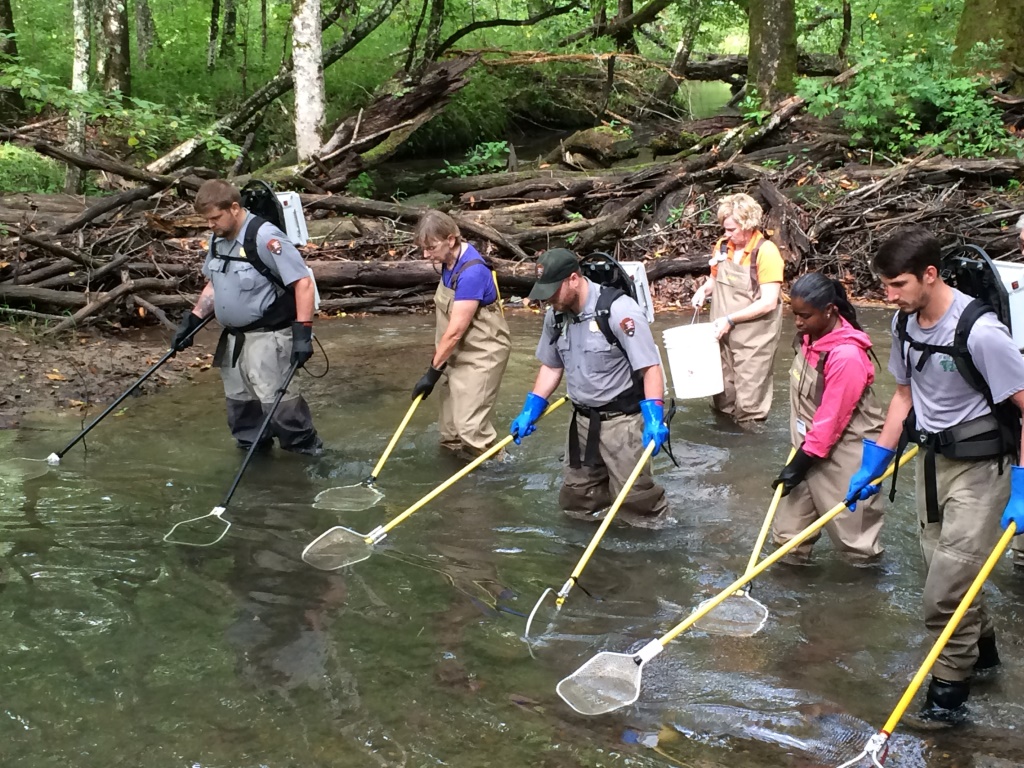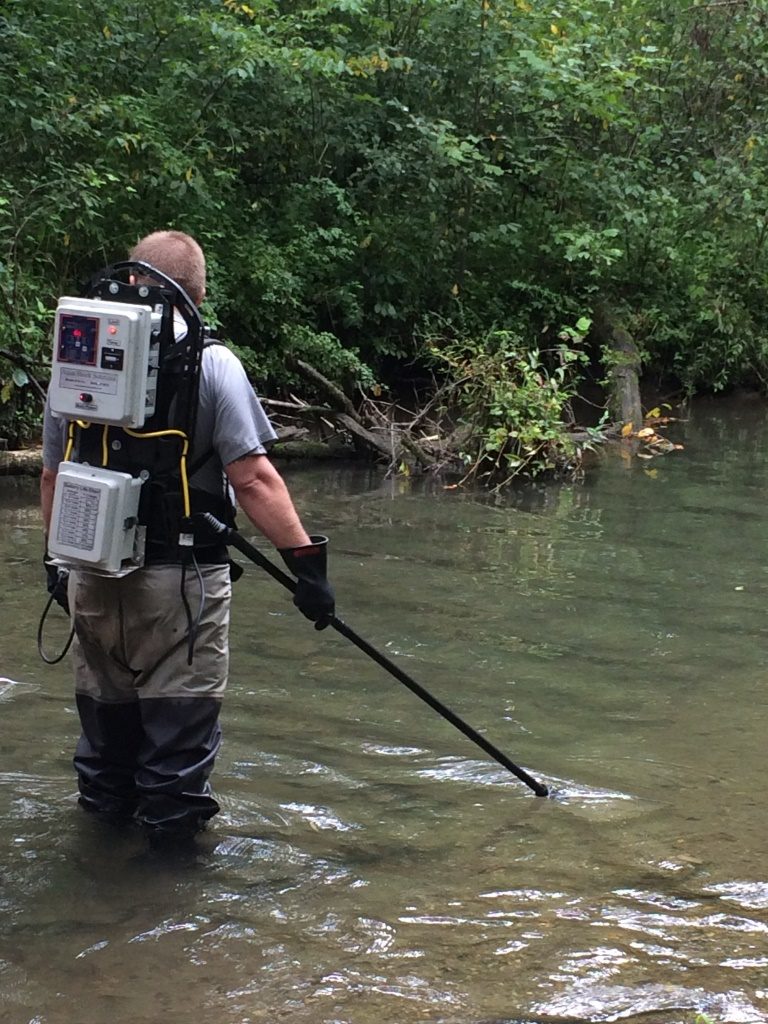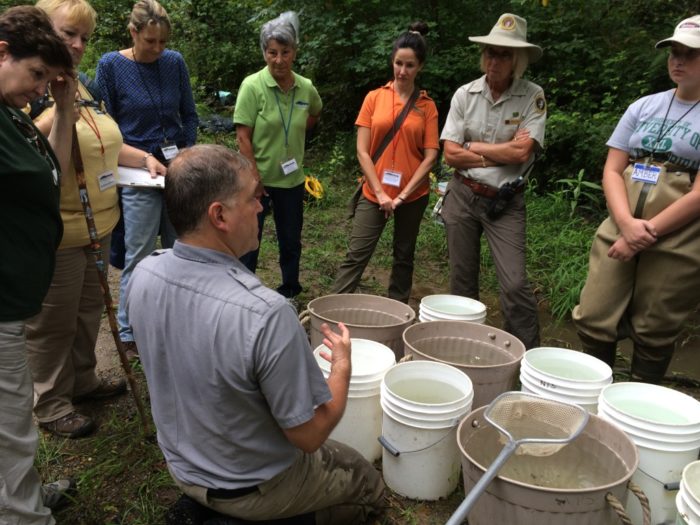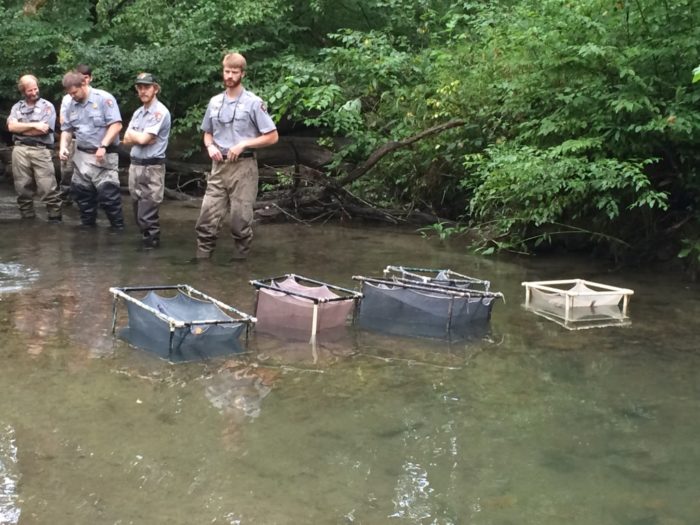The forecast had been calling for rain on Thursday the whole week running up to our second Experience Your Smokies session but as luck would have, we would stay dry — right up until we got into the creek.
For this session of EYS, we would be joining the park’s fisheries biologists to sample fish populations along Abrams Creek in Cades Cove. We were led by Matt Kulp, Supervisory Fisheries Biologist for Great Smoky Mountains National Park. After introducing his crew of full-time employees, seasonals, and interns, Ranger Matt started us off with a pop quiz: How do you catch fish in the park?
Fly fishing was the first answer from the group. Fly fishing relies on a good deal of skill, or in my case, divine intervention. Even the best fly fishermen could be there all afternoon and not catch a thing. Plus, we might miss out on fish species that don’t prefer fly-type baits. That was a good answer, but it wouldn’t really work for population sampling.
Drag a net up the stream? I think we’d catch more leaves than fish. Drop a stick of dynamite? Definitely not.
We would be fishing with electricity today! The thought formed in everyone’s head at the same time, “But isn’t that dangerous?”
Potentially…
In fact, the electro-shock packs the fisheries staff would be sporting could be cranked up to 700 volts, more than enough to defibrillate your heart. But we were using much lower voltages, just enough to stun the fish for a few seconds and not enough for us humans to even worry about. Still, we were decked out in rubber waders and insulated rubber gloves for our safety.
The electric current travels from a backpack battery bank down through two handheld probes into the water. The current then jumps out into the surrounding water and into any nearby fish. The stunned fish stop swimming and float up to the surface where we (the EYS volunteers) would scoop them up in a net and transfer them to a waiting bucket of water.
The buckets are taken back upstream to our base for the day. There they are identified, separated by species into other buckets, then recorded, weighed and measured. The fish are kept in a mesh bag in the flowing water until they can be returned to their habitat at the end of the afternoon, dazed and confused but unharmed.

There is a surprising wealth of information we can gather from these fish. Measuring the length and weight gives us a general picture of their health, just like when we stand on the scale at the doctor’s office. We also kept count of the number of different species we found (of the 68 fish species in the park) and how many individuals of each species we caught. Along with the water temperature and pH level of the water, this information tells us a great deal about the health of the stream overall.
These are delicate ecosystems and fish populations can be affected by pollution, predators, temperature fluctuations, and a multitude of other factors. Pollutants can come in the form of acid rain, particulate pollution from smoke and car exhaust or groundwater contamination. Pollution in the streams obviously affects the fish and aquatic life, but also plants and animals all across the park. And don’t forget, this is the water you drink too! The headwaters of many regional water sources start in the high elevations of Great Smoky Mountains National Park.
With about 2,900 miles of streams in the Smokies, the fisheries biologists have a lot of ground to cover. Luckily they don’t have to sample like this everywhere in the park. Instead, they select a handful of sites, some in Tennessee and some in North Carolina, to get a big picture view of stream health and water quality across the park as a whole. They also get funding help from groups like Friends of the Smokies as well as the local chapter of Trout Unlimited who volunteer for fisheries projects and also raise money.
We had an absolute blast learning all about fish and streams with the NPS crew. Without a doubt, this has to be one of the cooler jobs in Great Smoky Mountains National Park. And judging by the smiles on the faces of the fisheries crew all day, they know it too.
Read more from Ranger Matt on our blog: Making It Clear: Understanding Water Quality









